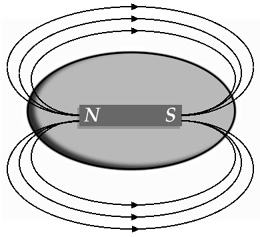
|

|
| Figure 1 | Figure 2 |
Compare the two figures below.

|

|
| Figure 1 | Figure 2 |
Figure 1 shows the electric flux due to a single positive charge +q. The flux is positive, since the electric field due to a positive charge moves outward to the Gaussian surface.
Figure 2 shows the magnetic flux due to a bar magnet with north (N) and south (S) poles. The magnetic flux emerges from N and ends at S. This means that what comes out of the Gaussian surface also goes into it. The magnetic flux is obviously zero.

This is Gauss's Law for magnetism, in integral form. (Compare it with
 , the integral form of
Gauss's Law.) It states that the
source of magnetism is the combination of a north pole and a south
pole. In differential form, it is
, the integral form of
Gauss's Law.) It states that the
source of magnetism is the combination of a north pole and a south
pole. In differential form, it is

This is also one of the four Maxwell's Equations.